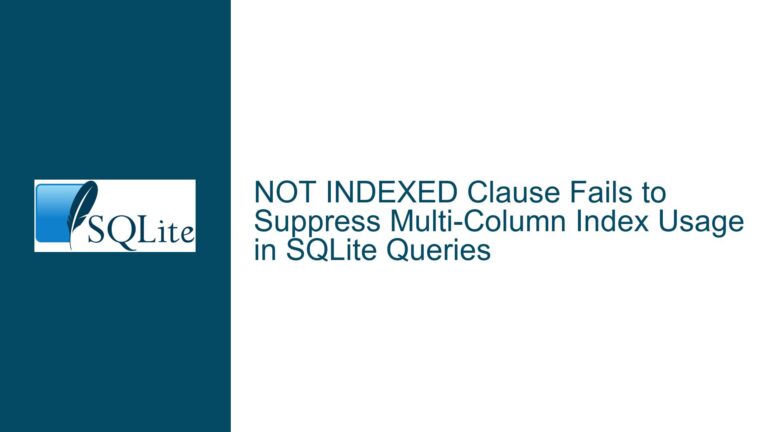Resolving Repeated Subqueries and Column Reference Errors in SQLite LIMIT Clauses
Understanding the Core Challenge: Dynamic Row Limitation Based on Cross-Table Conditions
The problem revolves around efficiently retrieving the oldest rows from table T2 when the total number of rows exceeds a threshold defined in table T1. The initial query uses repeated subqueries to calculate the difference between the count of rows in T2 and the maxrows value in T1, then applies this difference dynamically to the LIMIT clause. The goal is to simplify the query by avoiding redundant subqueries while resolving an error (no such column: t2_cnt.cnt) that arises when attempting to reference aliased values from subqueries in the LIMIT clause.
Key components of the problem:
- Tables and Relationships:
T1: Contains a single row (assumed) with a columnmaxrowsspecifying the maximum allowed rows inT2.T2: Contains rows with a date column (mydate). The requirement is to return the oldest rows that exceedT1.maxrows.
- Initial Query Structure:
SELECT id FROM T2 ORDER BY mydate LIMIT CASE WHEN (SELECT COUNT(*) FROM T2) > (SELECT maxrows FROM T1) THEN (SELECT COUNT(*) FROM T2) - (SELECT maxrows FROM T1) ELSE 0 END;This query works but repeats four subqueries, leading to redundancy and potential inefficiency.
- Error Scenario:
Attempts to simplify the query by aliasing subqueries in theFROMclause (e.g.,(SELECT COUNT(*) AS cnt FROM T2) t2_cnt) fail withError: no such column: t2_cnt.cntwhen referenced inLIMIT.
Root Causes: SQLite’s Handling of Subqueries and Constant Expressions
1. Subquery Aliasing in the FROM Clause and Scope Limitations
Subqueries in the FROM clause create derived tables that are logically evaluated before the SELECT, WHERE, or LIMIT clauses. However, SQLite enforces strict scoping rules:
- Column Visibility: Columns from derived tables (e.g.,
t2_cnt.cnt) are only accessible in theSELECTlist,WHERE,GROUP BY, orHAVINGclauses. TheLIMITclause operates outside the scope of these derived tables, making references to their columns invalid. - Example Breakdown:
SELECT id FROM T2, (SELECT COUNT(*) AS cnt FROM T2) t2_cnt, (SELECT maxrows FROM T1) max_t1 ORDER BY mydate LIMIT CASE WHEN t2_cnt.cnt > max_t1.maxrows THEN t2_cnt.cnt - max_t1.maxrows ELSE 0 END;Here,
t2_cntandmax_t1are cross-joined withT2, creating a Cartesian product. While this allows referencingt2_cnt.cntin theSELECTorWHEREclauses, theLIMITclause cannot resolve these aliases because it is evaluated after the result set is computed but before the query finishes execution.
2. Constant Expression Requirement for LIMIT and OFFSET
SQLite requires the LIMIT (and OFFSET) clause to be a constant expression at the time of query parsing. This means:
- The expression must be evaluable before the main query execution begins.
- References to runtime-derived values (e.g., results of subqueries or joins) are prohibited.
- Implication: Dynamic values calculated during query execution (like
t2_cnt.cnt - max_t1.maxrows) cannot be used directly inLIMIT.
3. Misunderstanding of SQLite’s Query Execution Order
SQLite processes queries in this order:
FROMclause (including joins and subqueries).WHEREclause.GROUP BYandHAVING.SELECT(including expressions and aliases).ORDER BY.LIMITandOFFSET.
The LIMIT clause is one of the final steps, meaning it cannot access intermediate results or aliases defined earlier in the query. This explains why t2_cnt.cnt is unrecognized in LIMIT.
Comprehensive Solutions: Simplification Techniques and Workarounds
1. Using Scalar Subqueries with MAX for Single Evaluation
Replace repeated subqueries with scalar subqueries evaluated once. This leverages the fact that MAX can handle negative values gracefully:
SELECT id
FROM T2
ORDER BY mydate
LIMIT MAX(
(SELECT COUNT(*) FROM T2) - (SELECT maxrows FROM T1),
0
);
- How It Works:
(SELECT COUNT(*) FROM T2)and(SELECT maxrows FROM T1)are evaluated once each.MAX(value, 0)ensures the limit is non-negative.
- Advantages:
- Eliminates redundant subqueries.
- Avoids referencing aliases in
LIMIT.
2. OFFSET-Based Pagination with Precomputed Threshold
Use OFFSET to skip the newest rows up to the maxrows threshold:
SELECT id
FROM T2
ORDER BY mydate DESC
LIMIT -1 -- Returns all rows
OFFSET (SELECT maxrows FROM T1);
- How It Works:
ORDER BY mydate DESCsorts rows newest to oldest.OFFET (SELECT maxrows FROM T1)skips the firstmaxrowsrows, returning the remaining (older) rows.LIMIT -1is a SQLite-specific syntax to remove the default row limit.
- Caveats:
- Requires sorting in descending order to use
OFFSETeffectively. - Performance impact on large tables due to full table scans.
- Requires sorting in descending order to use
3. Precomputing Values with Common Table Expressions (CTEs)
Use CTEs to compute values once and reference them in the main query:
WITH
t2_count AS (SELECT COUNT(*) AS cnt FROM T2),
t1_max AS (SELECT maxrows FROM T1)
SELECT id
FROM T2
ORDER BY mydate
LIMIT (SELECT MAX(cnt - maxrows, 0) FROM t2_count, t1_max);
- How It Works:
- CTEs
t2_countandt1_maxcompute the necessary values once. - The
LIMITclause uses a scalar subquery to reference these precomputed values.
- CTEs
- Advantages:
- Clear separation of concerns.
- Avoids Cartesian products from cross-joins.
4. Trigger-Based Row Count Maintenance
For high-performance scenarios, maintain the count of rows in T2 using triggers and store it in T1:
-- Add a column to T1 to store the current count of T2
ALTER TABLE T1 ADD COLUMN t2_count INTEGER DEFAULT 0;
-- Create triggers to update T1.t2_count automatically
CREATE TRIGGER t2_insert AFTER INSERT ON T2
BEGIN
UPDATE T1 SET t2_count = t2_count + 1;
END;
CREATE TRIGGER t2_delete AFTER DELETE ON T2
BEGIN
UPDATE T1 SET t2_count = t2_count - 1;
END;
-- Simplified query using precomputed count
SELECT id
FROM T2
ORDER BY mydate
LIMIT MAX((SELECT t2_count FROM T1) - (SELECT maxrows FROM T1), 0);
- Advantages:
- Eliminates
COUNT(*)scans onT2. - Ideal for large tables with frequent inserts/deletes.
- Eliminates
5. Window Functions for Row Numbering (SQLite 3.25+)
Use window functions to assign row numbers and filter dynamically:
SELECT id
FROM (
SELECT id, ROW_NUMBER() OVER (ORDER BY mydate) AS row_num
FROM T2
)
WHERE row_num <= (SELECT COUNT(*) FROM T2) - (SELECT maxrows FROM T1);
- How It Works:
- Assigns a row number to each row ordered by
mydate. - Filters rows where
row_numexceeds the threshold.
- Assigns a row number to each row ordered by
- Caveats:
- Requires SQLite 3.25 or later.
- Still involves a full table scan for
COUNT(*).
6. Combining COUNT and LIMIT in a Single Subquery
Use a subquery to compute the limit value once:
SELECT id
FROM T2
ORDER BY mydate
LIMIT (SELECT MAX(COUNT(*) - maxrows, 0) FROM T2, T1);
- How It Works:
- The subquery
SELECT MAX(COUNT(*) - maxrows, 0) FROM T2, T1computes the limit in a single step.
- The subquery
- Advantages:
- Minimal syntax with no CTEs or triggers.
7. Addressing the Cartesian Product Pitfall
The original error (no such column: t2_cnt.cnt) arises because cross-joins create a Cartesian product, but LIMIT cannot reference columns from these joins. To avoid this:
- Explicit Join Syntax:
SELECT id FROM T2 CROSS JOIN (SELECT COUNT(*) AS cnt FROM T2) t2_cnt CROSS JOIN (SELECT maxrows FROM T1) t1_max ORDER BY mydate LIMIT CASE WHEN t2_cnt.cnt > t1_max.maxrows THEN t2_cnt.cnt - t1_max.maxrows ELSE 0 END;- Why It Fails: Despite using
CROSS JOIN, theLIMITclause still cannot referencet2_cnt.cntdue to the constant expression requirement.
- Why It Fails: Despite using
- Workaround: Move the logic to the
WHEREclause or use a CTE (as shown earlier).
8. Edge Case Handling and Validation
- Empty Tables: Ensure
T1has exactly one row. IfT1is empty,(SELECT maxrows FROM T1)returnsNULL, causing the limit to beMAX(NULL, 0) = 0. - Negative Limits: Use
MAX()to ensure the limit is non-negative. - Indexing: Add an index on
mydateto speed up sorting:CREATE INDEX idx_t2_mydate ON T2(mydate);
Final Recommendations
- For Small Datasets: Use the
MAXfunction with scalar subqueries for simplicity. - For Large Datasets: Implement trigger-based count maintenance to avoid
COUNT(*)scans. - When Using OFFSET: Ensure the
mydatecolumn is indexed and monitor performance. - Avoid Cross-Joins in LIMIT: Prefer CTEs or precomputed values to reference dynamic limits.
By understanding SQLite’s evaluation order and constant expression constraints, developers can craft efficient queries that avoid redundancy and runtime errors.






